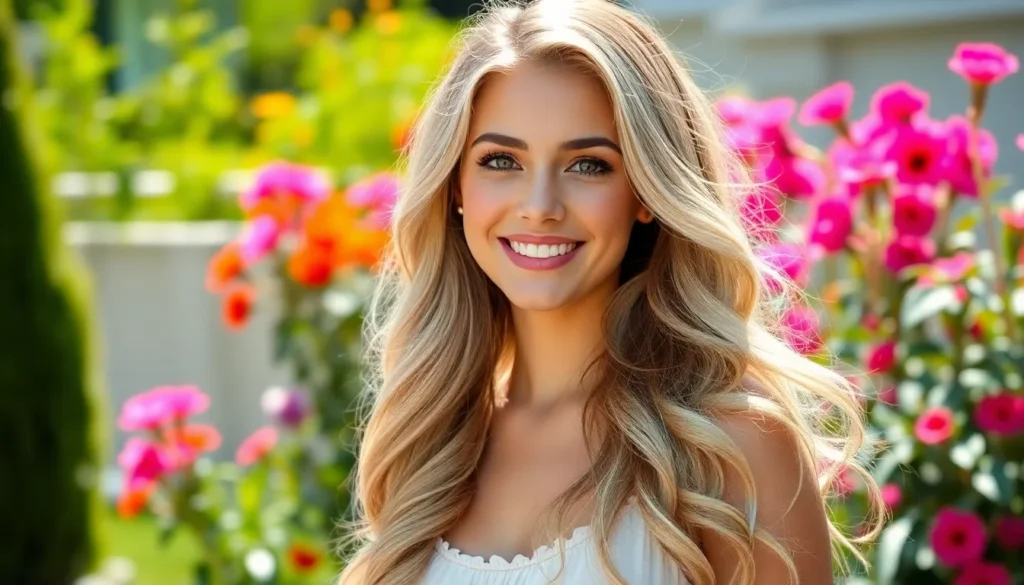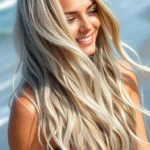Blonde long hair has captivated hearts and turned heads for centuries, representing the ultimate symbol of beauty and elegance across cultures worldwide. From Hollywood’s golden age icons to today’s social media influencers, this timeless combination continues to dominate beauty trends and inspire countless transformations.
We’ve all witnessed the magnetic appeal of flowing blonde locks – whether it’s the sun-kissed beach waves or the sleek platinum perfection that graces red carpets. But achieving and maintaining that perfect blonde shade while keeping your hair long and healthy isn’t just about picking the right color at the salon.
The journey to stunning blonde long hair involves understanding your skin tone, choosing the perfect shade, and mastering the art of proper hair care. We’ll guide you through everything you need to know about embracing this coveted look, from the initial transformation process to the daily maintenance routines that’ll keep your blonde locks looking absolutely radiant.
Achieve the Perfect Platinum Blonde for Long Hair
Platinum blonde represents the ultimate goal for many long-haired beauties seeking that coveted icy, white-blonde finish. We’ll guide you through the essential steps to achieve this stunning look while keeping your lengthy locks healthy and strong.
Choosing the Right Shade of Blonde
Cool undertones work best with true platinum blonde shades that have silver or ashy bases. We recommend consulting with a colorist to determine if your skin tone can handle the starkness of platinum, as warmer complexions often benefit from slightly creamier blonde variations.
Level 10 blonde represents the lightest achievable shade on the hair color scale, requiring your hair to be lifted to nearly white before toning. Platinum shades typically fall between levels 9 and 10, with level 10 being the iciest option available.
Your natural hair color determines how many lightening sessions you’ll need to reach platinum perfection. Dark brown or black hair may require 3-4 bleaching sessions spaced weeks apart, while medium brown hair often needs 2-3 sessions to achieve the desired lightness.
Professional vs. At-Home Bleaching Options
Professional colorists possess the expertise and high-quality products necessary to lift long hair to platinum levels safely. We strongly recommend salon visits for initial lightening sessions, as professionals can assess your hair’s condition throughout the process and adjust formulations accordingly.
At-home bleaching kits may seem cost-effective but rarely contain strong enough developers to achieve true platinum results on long hair. Box bleaches often cause uneven lifting, leaving you with brassy patches that require professional correction.
Maintenance touch-ups can sometimes be done at home once you’ve achieved your desired platinum base through professional services. We suggest using only salon-recommended products and limiting at-home touch-ups to root areas that are less than 2 inches of new growth.
Protecting Hair During the Lightening Process
Deep conditioning treatments should begin 2-3 weeks before your first bleaching appointment to strengthen your hair’s protein structure. We recommend weekly protein masks and daily leave-in conditioners to create a protective barrier against chemical damage.
Olaplex or similar bond-building treatments help maintain your hair’s structural integrity during the bleaching process. Professional colorists often incorporate these products directly into bleach formulations, reducing breakage by up to 70% during lightening sessions.
Heat styling restrictions become crucial during your platinum transformation journey, as bleached hair is significantly more vulnerable to thermal damage. We advise avoiding hot tools completely for 48-72 hours after each bleaching session and using heat protectants whenever styling is necessary.
Purple shampoo usage starts immediately after achieving your platinum shade to combat yellow and brassy tones that naturally develop over time. We recommend using purple shampoo 2-3 times per week, alternating with gentle, sulfate-free cleansers to maintain your icy blonde perfection.
Master Essential Care Routines for Healthy Blonde Long Hair
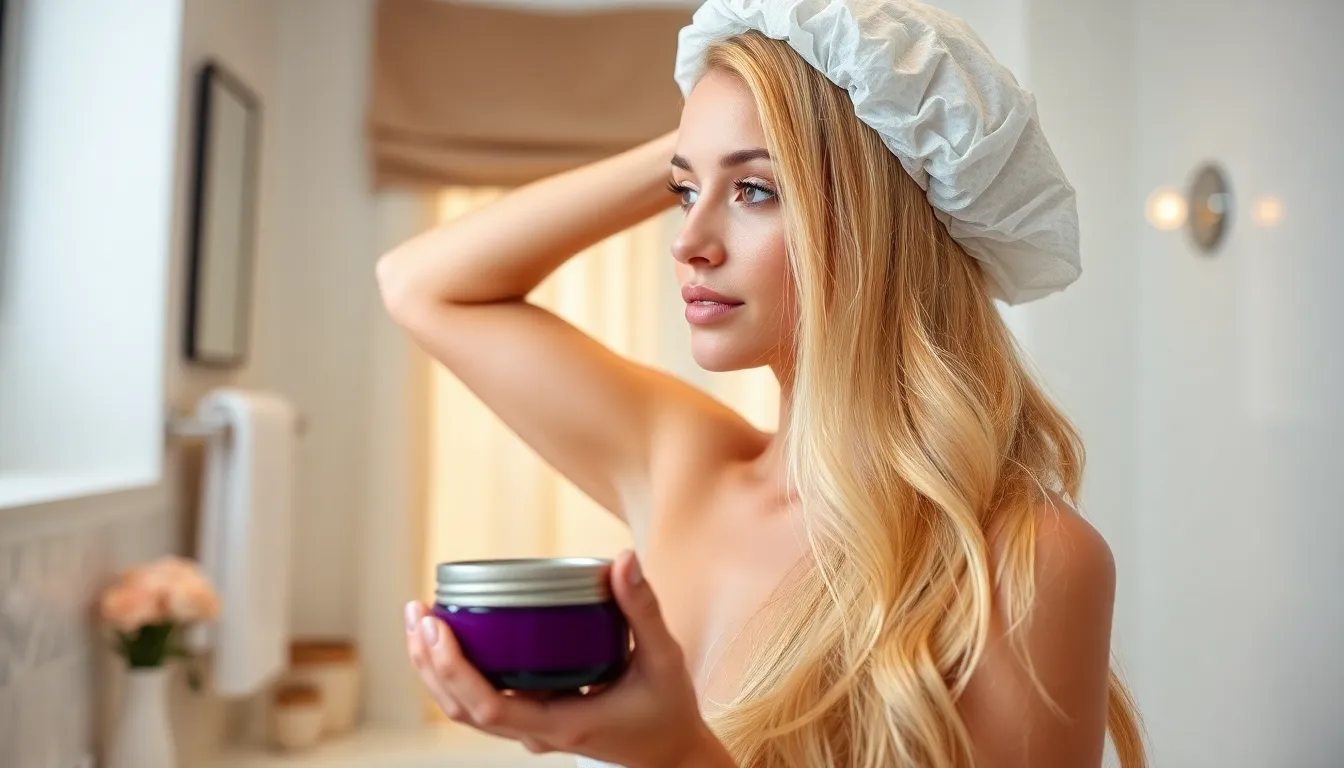
Maintaining gorgeous blonde long hair demands consistent care routines that address the unique needs of lightened strands. We’ve developed proven strategies that keep your blonde locks vibrant and strong.
Weekly Deep Conditioning Treatments
Apply protein rich masks every 7 to 10 days to rebuild the hair structure damaged during the bleaching process. We recommend using products containing keratin or hydrolyzed wheat protein that penetrate deep into the hair shaft. Focus treatments on mid lengths and ends where damage typically concentrates most heavily in long blonde hair.
Leave conditioning masks on for 15 to 20 minutes under a shower cap to maximize absorption and effectiveness. We suggest alternating between protein treatments and moisture rich masks to maintain the perfect balance your blonde hair craves. Choose products specifically formulated for color treated hair to ensure ingredients won’t strip your blonde tones or cause unwanted brassiness.
Purple Shampoo Usage and Timing
Use purple shampoo 2 to 3 times per week to neutralize yellow and brassy tones that naturally develop in blonde hair over time. We recommend applying it to damp hair and leaving it on for 3 to 5 minutes before rinsing thoroughly. Start with once weekly applications if you’re new to purple shampoo to avoid over toning your blonde shades.
Time your purple shampoo sessions based on how quickly your hair develops brassiness after coloring appointments. We’ve found that fine hair textures may need more frequent treatments while coarse hair typically requires less. Monitor your blonde tones closely and adjust usage frequency to maintain your desired shade without creating an ashy or gray appearance.
Heat Protection Strategies
Apply heat protectant products to every section before using blow dryers, flat irons, or curling tools on your blonde long hair. We recommend products with silicone bases that create a barrier between your hair and styling tools heated above 300°F. Keep styling temperatures below 350°F to prevent excessive damage to already compromised blonde strands.
Use ceramic or tourmaline styling tools that distribute heat more evenly and reduce hot spots that can cause breakage in long blonde hair. We suggest investing in tools with adjustable temperature settings so you can customize heat levels based on your hair’s current condition. Limit heat styling to 2 to 3 times per week and embrace air drying or heatless styling methods whenever possible to preserve your blonde hair’s integrity.
Style Your Blonde Long Hair for Maximum Impact
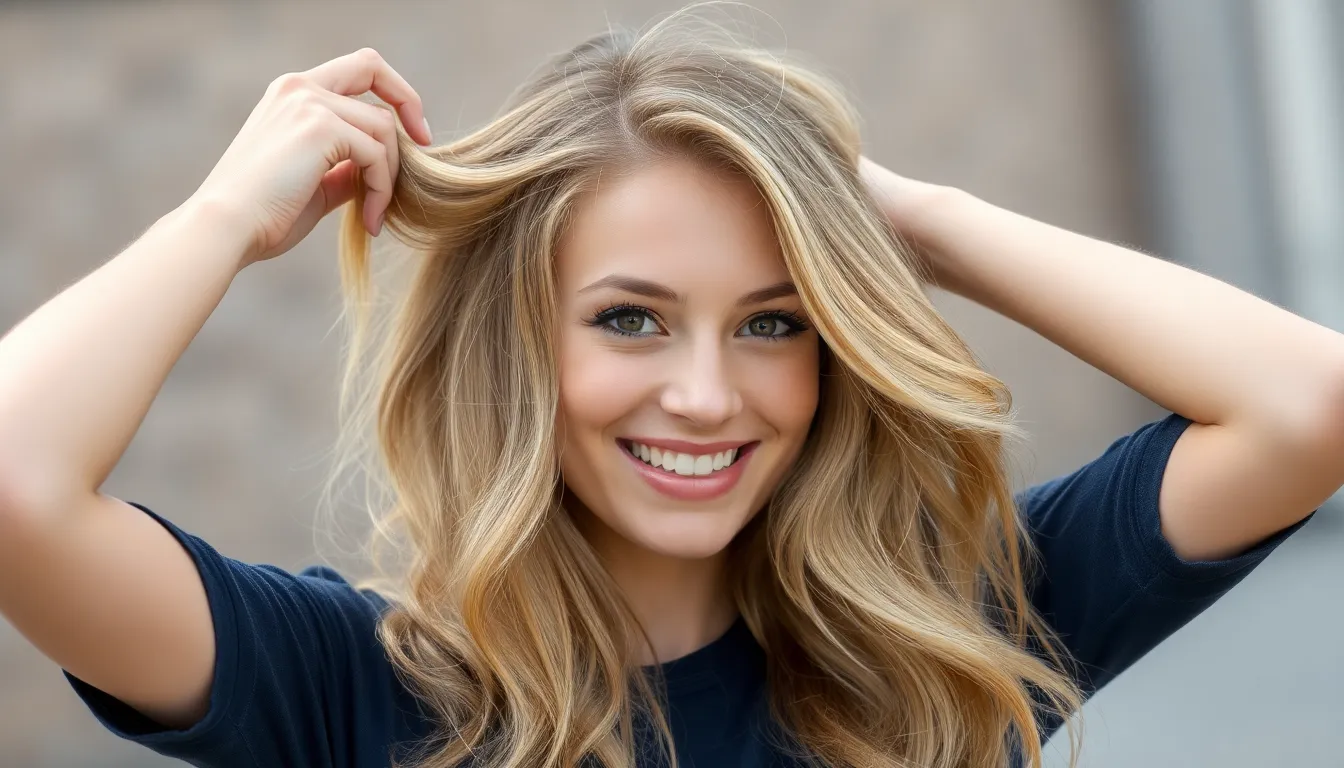
Now that we’ve established your perfect platinum shade and care routine, let’s explore styling techniques that’ll make your blonde locks truly stunning. We’ll focus on three versatile approaches that complement blonde hair’s natural luminosity.
Effortless Beach Waves Techniques
Scrunching with sea salt spray creates the most natural looking waves for blonde long hair. We recommend applying the spray to damp hair from mid-length to ends, then gently scrunching upward with your hands. This technique enhances blonde hair’s texture while adding volume and movement.
Braiding damp hair overnight produces gorgeous waves without heat damage. We suggest creating 2 to 3 loose braids before bed, then gently finger combing them out in the morning. Your blonde hair will have soft, romantic waves that last all day.
Using a diffuser on low heat preserves your hair’s health while creating defined waves. We apply a curl improving cream to towel dried hair, then scrunch sections while diffusing. This method works particularly well for maintaining blonde hair’s integrity since it reduces direct heat exposure.
Twisting small sections around your finger while hair air dries creates effortless spiral waves. We work with 1 inch sections, twist them tightly, then release once completely dry. This technique gives blonde long hair a naturally tousled appearance that’s perfect for casual occasions.
Sleek Straight Styling Methods
Blow drying with a round brush creates the smoothest foundation for straight blonde styles. We use a 2 inch barrel brush, working in small sections from roots to ends while directing airflow downward. This technique seals the hair cuticle and enhances blonde hair’s natural shine.
Using a high quality flat iron with adjustable temperature settings protects blonde hair during straightening. We recommend keeping the temperature between 300 to 350 degrees Fahrenheit for healthy hair, making single passes to avoid repeated heat exposure. Always apply a heat protectant before styling to maintain your hair’s moisture balance.
Sectioning hair into manageable pieces ensures even straightening results throughout your long blonde locks. We divide hair into 4 to 6 horizontal sections, clipping upper layers away while working on lower sections first. This systematic approach prevents missed spots and reduces styling time.
Finishing with a smoothing serum locks in your sleek style while adding extra shine to blonde hair. We apply a small amount from mid length to ends, avoiding the roots to prevent greasiness. This final step creates that glossy, salon fresh appearance that makes blonde hair look incredibly healthy.
Elegant Updo Options for Special Occasions
Creating a low chignon showcases blonde hair’s sophistication for formal events. We gather hair at the nape of the neck, twist it into a loose coil, then secure with bobby pins that match your blonde shade. This classic style highlights facial features while keeping long hair elegantly contained.
Building a textured top knot adds modern flair to traditional updos for blonde long hair. We tease the crown section for volume, then gather all hair into a high ponytail before twisting and wrapping it around the base. Pulling out a few face framing pieces softens the look and shows off blonde highlights.
Styling a braided crown creates a romantic updo perfect for weddings or special occasions. We begin with a Dutch braid along the hairline, incorporating sections as we work around the head, then gather remaining length into a low bun. This intricate style makes blonde hair appear luminous under event lighting.
Fashioning a twisted side updo offers asymmetrical elegance for blonde long hair. We create deep side part, then twist sections from the heavier side back toward the opposite ear before securing in a low side bun. This sophisticated style works beautifully with blonde hair’s natural movement and texture.
Choose the Most Flattering Blonde Long Hair Cuts
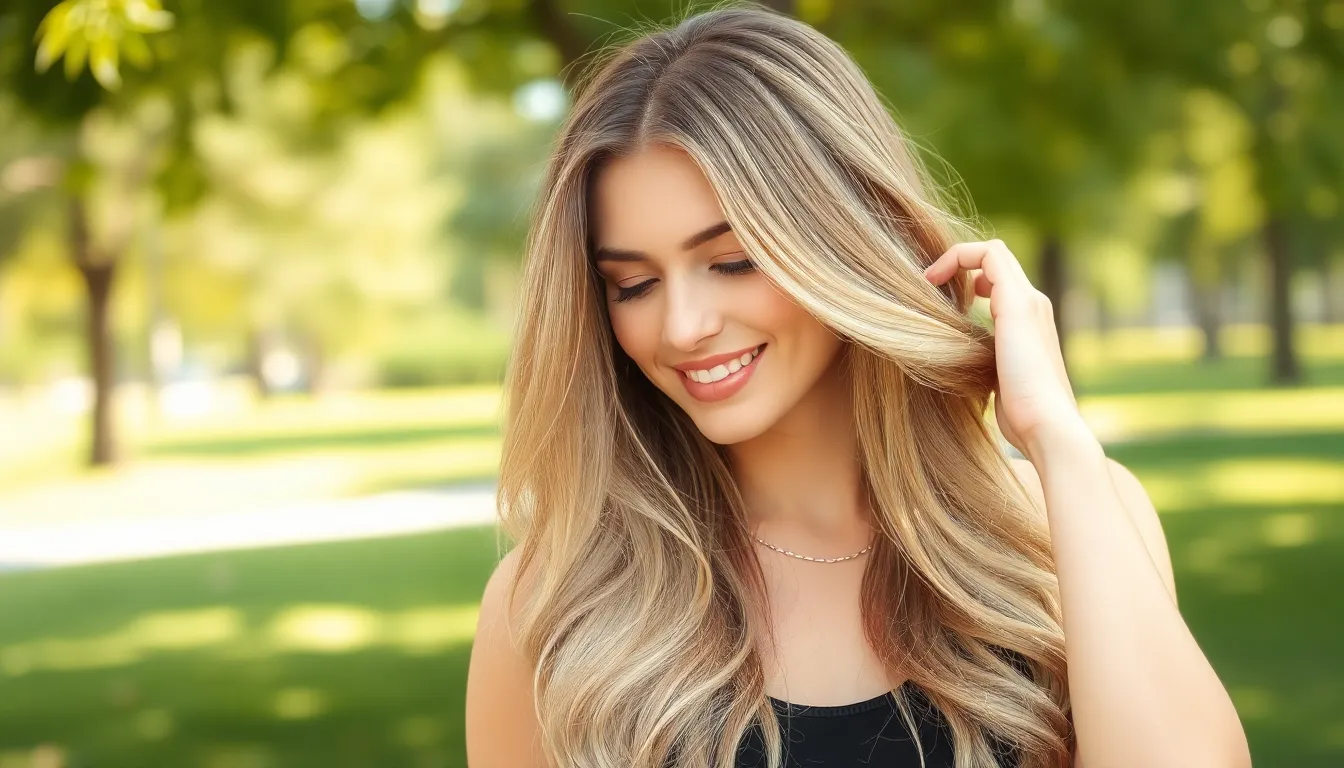
Finding the perfect cut enhances your blonde hair’s natural beauty and creates stunning visual impact. We’ll explore three essential cutting techniques that maximize your long blonde hair’s potential.
Layered Cuts for Volume and Movement
Long layers create natural body and movement throughout your blonde hair while maintaining length. Professional stylists cut these layers at varying lengths to add dimension without sacrificing overall hair thickness.
Feathered layers work exceptionally well for blonde hair because they catch light beautifully and create soft texture. Start these layers around your collarbone and extend them gradually toward the ends for a seamless blend.
Cascading layers provide maximum volume at the crown while keeping weight at the bottom. Request layers that begin 3 to 4 inches below your shoulders to maintain fullness while adding movement.
Subtle layering offers a gentler approach for those who want movement without dramatic texture changes. These delicate layers create soft dimension and enhance your blonde shade’s luminosity.
Blunt Cuts for Dramatic Effect
One-length blunt cuts create striking visual weight and make your blonde color appear more saturated. This cut works best on straight to slightly wavy hair textures and requires regular maintenance every 6 to 8 weeks.
Blunt lobs (long bobs) ending at your collarbone provide modern sophistication while showcasing blonde tones. These cuts create clean lines that emphasize your hair’s healthy appearance and color vibrancy.
Asymmetrical blunt cuts add contemporary edge to traditional one-length styles. Request subtle angle variations where one side sits slightly longer than the other for visual interest.
Textured blunt ends combine the drama of blunt cuts with subtle movement. Your stylist uses point cutting techniques on the very ends to soften the harsh line while maintaining the cut’s impact.
Face-Framing Techniques for Different Face Shapes
Oval faces work beautifully with most blonde long hair cuts, particularly those featuring soft layers starting at the cheekbones. These cuts enhance natural bone structure without overwhelming facial features.
Round faces benefit from longer layers that create vertical lines and elongate appearance. Start face-framing layers below the chin and avoid adding volume at the sides near your cheeks.
Square faces look stunning with soft, wispy layers that begin at jaw level to soften angular features. These gentle layers create movement around the face while maintaining your hair’s overall length.
Heart-shaped faces pair perfectly with layers that add width at jaw level and below. Request fuller layers starting at your chin to balance a wider forehead with a narrower jawline.
Long faces work well with horizontal layers that create width rather than length. Ask for subtle layers that start around your shoulders to add fullness without elongating your face further.
Maintain Your Blonde Long Hair Color Between Salon Visits
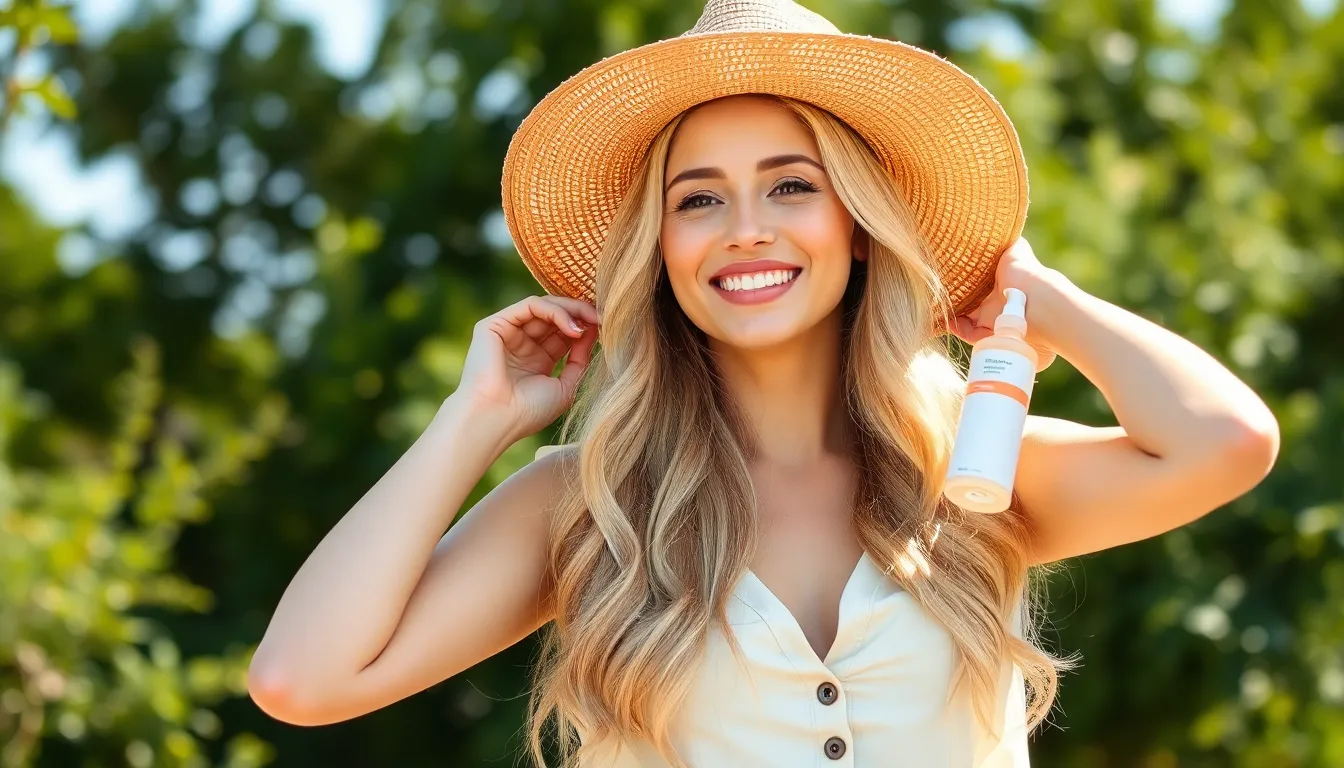
We understand that keeping your blonde long hair looking fresh and vibrant requires consistent maintenance between professional appointments. Strategic at-home care helps preserve your color investment while extending the life of your salon results.
Root Touch-Up Answers
Root touch-up kits provide temporary coverage for new growth until your next salon visit. We recommend choosing a shade slightly lighter than your natural color to blend seamlessly with your bleached lengths. Temporary root concealers like Madison Reed Root Touch Up or L’Oreal Magic Root Cover Up offer quick fixes that wash out with your next shampoo.
Semi-permanent options work well for covering stubborn grays or darker regrowth patterns. Products like Clairol Nice ‘n Easy Root Touch-Up deliver 2 to 3 weeks of coverage without harsh ammonia formulas. Apply these treatments only to visible roots using a small brush or applicator tip.
Powder concealers create instant camouflage for special events or between washes. Brands like Color Wow Root Cover Up blend naturally with blonde tones and resist transfer onto clothing. Spray these products 6 to 8 inches away from your hairline for even distribution.
Toning Treatments at Home
Purple shampoo remains the most effective tool for neutralizing yellow and brassy tones in blonde hair. We suggest using products like Fanola No Yellow Shampoo or Redken Color Extend Blondage 2 to 3 times weekly. Leave the formula on wet hair for 3 to 5 minutes before rinsing thoroughly.
Toning masks provide deeper color correction than regular shampoos alone. Matrix Total Results So Silver Mask or Joico Color Balance Purple Shampoo offer intensive treatments for severely brassy hair. Apply these masks once weekly to damp hair, focusing on the most discolored sections.
Blue based toners work better for orange undertones that sometimes appear in lighter blonde shades. Products containing blue pigments like Wella T18 Lightest Ash Blonde help counteract unwanted warmth. Mix these toners with 20 volume developer according to package instructions for best results.
| Toning Product Type | Frequency | Application Time | Best For |
|---|---|---|---|
| Purple shampoo | 2-3 times weekly | 3-5 minutes | Yellow tones |
| Toning masks | Once weekly | 10-15 minutes | Severe brassiness |
| Blue toners | As needed | 15-20 minutes | Orange undertones |
Sun Protection for Color Preservation
UV rays cause blonde hair color to fade and develop unwanted yellow tones over extended exposure periods. We always recommend applying UV protective hair products before spending time outdoors. Leave-in treatments like Aveda Sun Care Protective Hair Veil create invisible barriers against harmful solar radiation.
Spray protectants offer convenient application for active lifestyles and beach activities. Products such as Bumble and Bumble Hairdresser’s Invisible Oil Heat/UV Protective Primer shield hair cuticles while maintaining natural movement. Reapply these sprays every 2 hours during prolonged sun exposure.
Physical barriers provide the most reliable protection for maintaining blonde hair color integrity. Wide brimmed hats, silk scarves, and protective hair wraps block direct sunlight from reaching your strands. Choose accessories in light colors to reflect heat and prevent additional color damage from occurring.
Accessorize Your Blonde Long Hair Like a Pro
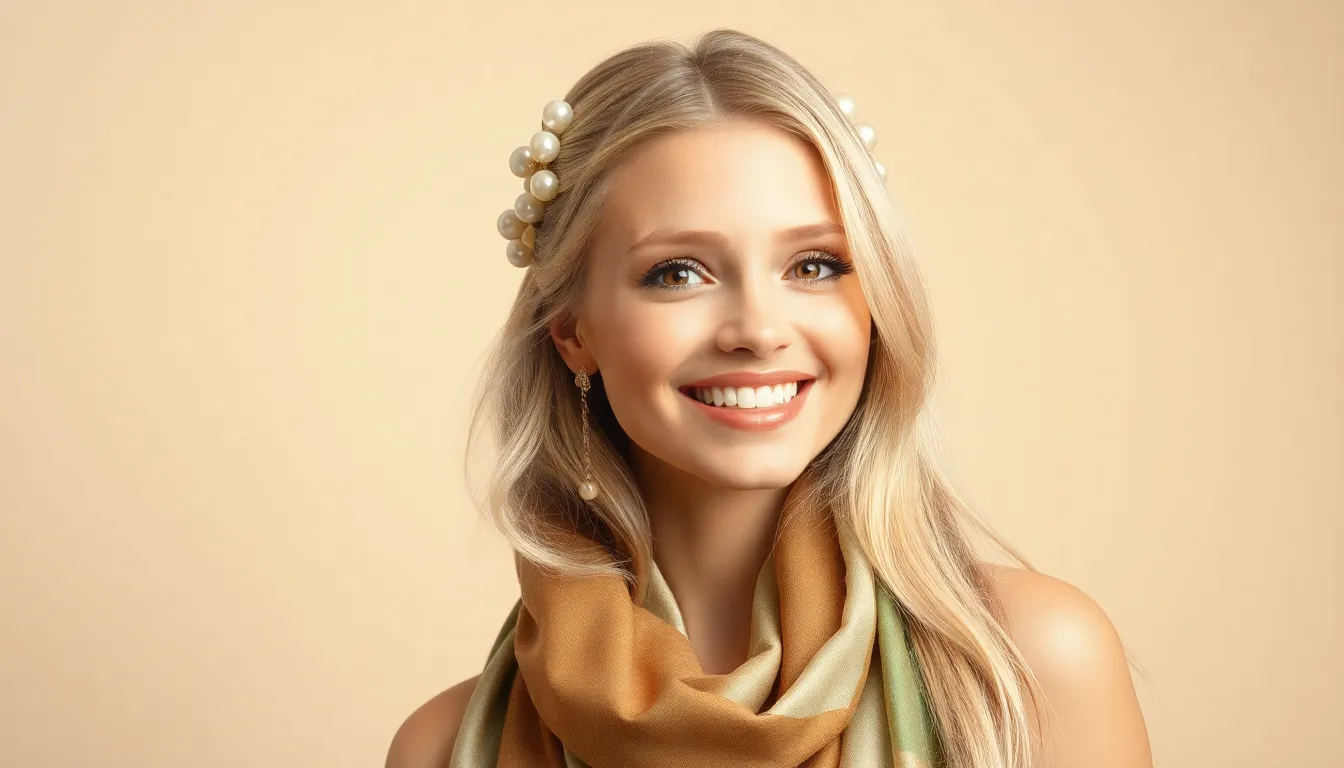
Accessorizing blonde long hair effectively transforms your look from ordinary to extraordinary with the right styling choices. We’ll explore essential accessories, makeup techniques, and wardrobe selections that make your blonde locks the perfect foundation for stunning overall appearances.
Hair Accessories That Complement Blonde Tones
Metallic hair accessories create striking contrasts against blonde shades, with rose gold clips and bobby pins offering warmth that enhances honey and strawberry blonde tones. Silver and platinum accessories work beautifully with ash blonde and platinum shades, creating cohesive metallic harmony throughout your styling choices.
Silk scarves and headbands provide elegant styling options while protecting your blonde hair from environmental damage and friction. Choose cream, champagne, or soft pink silk accessories to complement warm blonde tones, or opt for cool gray and white options for platinum and ash blonde shades.
Pearl-adorned accessories bring timeless sophistication to blonde long hair, with pearl barrettes, headbands, and hair combs creating classic elegance for formal occasions. These accessories naturally complement the luminous quality of blonde hair while adding texture and visual interest to updos and half-up styles.
Tortoiseshell accessories offer versatile styling options that work across different blonde shades, from classic brown tortoiseshell patterns to blonde tortoiseshell variations that blend seamlessly with your hair color. Hair clips, headbands, and decorative combs in tortoiseshell patterns create sophisticated looks for both casual and professional settings.
Makeup Colors That Enhance Blonde Hair
Eyeshadow palettes in bronze, copper, and gold tones create stunning warmth that complements most blonde hair shades while making blue and green eyes particularly striking. Neutral browns and taupes provide everyday versatility, while soft pinks and corals add feminine touches that enhance the softness of blonde tones.
Mascara and eyeliner choices significantly impact how blonde hair frames your face, with brown mascara creating softer definition for lighter blonde shades and black mascara providing dramatic contrast for platinum and darker blonde tones. Navy or deep brown eyeliner offers sophisticated alternatives to harsh black while maintaining definition around the eyes.
Lip color selections should balance the overall look, with nude pinks and peach tones creating natural harmony with warm blonde shades. Berry and rose colors provide beautiful contrast against cooler blonde tones, while classic red lipstick creates timeless glamour that works across all blonde variations.
Blush application in soft peach, coral, or rose tones adds healthy warmth to complement blonde hair while avoiding competition with your hair color. Apply blush to the apples of your cheeks and blend upward toward the temples to create lifted, youthful definition that enhances your overall blonde aesthetic.
Wardrobe Choices for Stunning Blonde Looks
Color coordination plays a crucial role in creating cohesive looks, with jewel tones like emerald green, sapphire blue, and deep purple creating striking contrasts that make blonde hair appear more vibrant. Soft pastels including blush pink, lavender, and mint green complement blonde tones while creating romantic, feminine appearances.
Neutral wardrobe staples in cream, camel, and soft gray provide versatile foundation pieces that highlight blonde hair without overwhelming your overall look. Black clothing creates dramatic contrast that works particularly well with platinum and ash blonde shades, while white and off-white pieces complement warmer blonde tones beautifully.
Metallic accents in your wardrobe should align with your blonde hair’s undertones, with gold jewelry and accessories improving warm blonde shades and silver or platinum pieces complementing cooler blonde tones. Incorporate metallic elements through belts, shoes, handbags, and jewelry to create coordinated styling that elevates your blonde hair.
Fabric choices impact how your blonde hair appears against your clothing, with smooth fabrics like silk and satin creating elegant backdrops that showcase hair’s natural shine. Textured fabrics including knits and tweeds provide interesting contrast while matte finishes prevent competition with your hair’s natural luminosity.
Avoid Common Blonde Long Hair Mistakes

Maintaining gorgeous blonde long hair requires avoiding several critical mistakes that can compromise both color integrity and hair health. We’ve identified the most damaging habits that prevent many people from achieving their dream blonde locks.
Overwashing and Damage Prevention
Overwashing strips essential oils from blonde hair, leaving strands dry and brittle. We recommend washing blonde long hair only 2 to 3 times per week to preserve natural moisture levels. Color-treated blonde hair loses its protective sebum layer faster than natural hair, making frequent washing particularly damaging.
Sulfate-based shampoos accelerate color fading and create unwanted brassiness in blonde tones. Choose sulfate-free formulas specifically designed for color-treated hair to extend your salon results. Purple shampoos should replace regular cleansers during washing sessions to maintain cool blonde tones.
Hot water opens hair cuticles and allows blonde pigments to escape more rapidly. Rinse with lukewarm water during washing and finish with a cool water rinse to seal cuticles. This simple temperature adjustment can extend your color by up to 3 weeks between salon visits.
Aggressive towel drying creates breakage in fragile blonde strands. Pat hair gently with a microfiber towel or cotton t-shirt to remove excess moisture. Wet blonde hair stretches up to 30% more than dry hair, making it extremely vulnerable to mechanical damage.
Chemical Processing Timing Issues
Rushing between chemical services leads to severe breakage and uneven color results. Wait at least 2 to 3 weeks between major chemical processes like bleaching, perming, or relaxing treatments. Professional colorists assess hair integrity before proceeding with additional lightening sessions.
Overlapping previously processed hair during touch-ups creates weak points and potential breakage zones. Apply new bleach or color only to virgin roots, avoiding areas that were lightened in previous appointments. This targeted approach prevents double processing and maintains hair strength throughout the length.
Ignoring strand tests before major changes results in unpredictable color outcomes and potential hair damage. Perform patch tests 48 hours before any new chemical service to check for allergic reactions. Professional colorists always test small sections to predict how your hair will respond to new formulations.
Scheduling multiple services in one session overwhelms blonde hair’s chemical tolerance limits. Book separate appointments for major color changes, cuts, and chemical treatments spaced at least 1 week apart. Your hair needs recovery time between intensive salon services to rebuild its natural protective barriers.
Heat Styling Overuse Problems
Daily heat styling weakens blonde hair structure and accelerates color fading more than any other styling habit. Limit heated tool usage to 3 times per week maximum and incorporate heat-free styling methods. Blonde hair has already undergone chemical stress during the lightening process, making it more susceptible to thermal damage.
Skipping heat protectant products exposes blonde strands to temperatures exceeding 300°F during styling sessions. Apply thermal protection spray or cream to damp hair before any heated styling tool contact. Quality heat protectants create a barrier that reduces moisture loss and prevents protein breakdown.
Using maximum temperature settings on styling tools causes immediate cuticle damage and long-term structural weakness. Set flat irons to 300°F or lower and curling irons to 250°F for blonde hair maintenance. Fine blonde hair requires even lower temperatures, typically between 200°F to 250°F for safe styling.
Neglecting regular tool maintenance leads to uneven heat distribution and increased styling damage. Clean styling tools weekly with rubbing alcohol to remove product buildup that creates hot spots. Replace old or damaged heating elements that no longer maintain consistent temperatures across the styling surface.
Embrace Trending Blonde Long Hair Looks
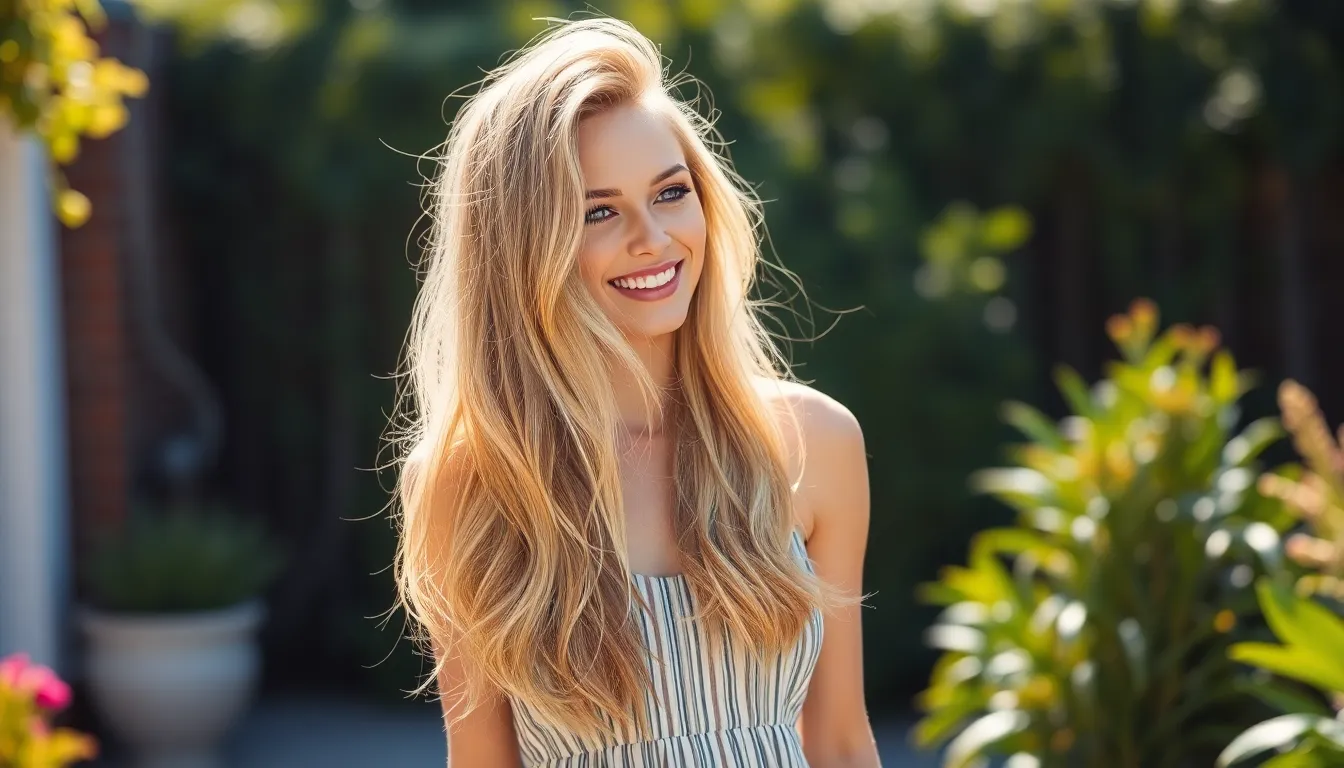
Modern blonde techniques have revolutionized how we approach long hair coloring, offering natural-looking dimension and depth. These contemporary methods create stunning visual effects that enhance your hair’s natural beauty while maintaining healthy integrity.
Balayage and Highlighting Techniques
Balayage creates the most natural-looking blonde dimension for long hair. This hand-painted technique allows colorists to place highlights exactly where sunlight would naturally hit your hair. We recommend requesting face-framing pieces that start 2 to 3 inches from your roots to create a soft, grown-out appearance.
Foil highlights offer precise control over blonde placement and saturation. Traditional highlighting uses aluminum foils to separate hair sections during the lightening process. Partial highlights focus on the crown and face-framing areas, while full highlights cover the entire head for maximum blonde coverage.
Babylights deliver subtle, sun-kissed dimension that mimics childhood hair color. This technique uses ultra-fine sections to create delicate, natural-looking highlights throughout long hair. Colorists typically use a weaving cap or fine sectioning to achieve the precise placement needed for this sophisticated look.
Ribbon highlighting adds bold contrast without overwhelming your natural base color. This method places thicker, more prominent blonde sections throughout long hair to create dramatic visual interest. We suggest spacing ribbon highlights 1 to 2 inches apart for optimal impact while maintaining hair health.
Ombre and Color Melting Styles
Classic ombre creates a striking gradient from dark roots to light blonde ends. This technique typically begins the color transition at mid-length, allowing 6 to 8 inches of natural root color for low maintenance. Professional colorists use multiple toning sessions to achieve smooth color transitions without harsh lines.
Sombre offers a softer, more subtle version of traditional ombre coloring. This “soft ombre” technique creates gentle color variations that blend seamlessly from roots to ends. We recommend sombre for those wanting blonde dimension without dramatic contrast or frequent touch-ups.
Color melting blends multiple blonde tones for seamless, multidimensional results. This advanced technique uses 3 to 4 different blonde shades that melt into each other throughout long hair. Colorists apply toners in overlapping sections to create smooth transitions between ash blonde, honey blonde, and platinum tones.
Shadow roots add depth and dimension while extending time between salon visits. This technique intentionally darkens the root area by 1 to 2 shades darker than the mid-lengths. Shadow roots create natural-looking contrast and help blonde hair appear fuller while reducing maintenance requirements.
Seasonal Blonde Variations
| Season | Blonde Tone | Key Characteristics | Maintenance Level |
|---|---|---|---|
| Spring | Butter Blonde | Warm, creamy undertones | Medium |
| Summer | Platinum Ice | Cool, silvery finish | High |
| Fall | Honey Caramel | Rich, golden highlights | Low |
| Winter | Champagne | Neutral, sophisticated tones | Medium |
Spring blonde incorporates warm butter and cream tones that complement fresh seasonal energy. These shades feature golden undertones that brighten complexions and create youthful radiance. Colorists often add peachy or strawberry highlights to enhance the warm blonde base.
Summer platinum delivers cool, icy tones perfect for the bright season. This high-maintenance shade requires professional toning every 6 to 8 weeks to maintain its pristine appearance. We recommend using purple shampoo 3 times weekly to prevent brassiness in summer heat.
Fall honey blonde embraces rich caramel and amber tones that mirror autumn foliage. These deeper blonde shades require less frequent touch-ups and complement cozy seasonal fashion choices. Colorists blend honey highlights with chocolate lowlights for maximum dimensional impact.
Winter champagne blonde offers sophisticated neutral tones with subtle shimmer. This versatile shade works beautifully with both warm and cool skin tones throughout the colder months. Professional colorists use pearl and silver toners to achieve the refined champagne finish.
Conclusion
Long blonde hair remains one of the most coveted and versatile looks in the beauty industry. We’ve explored everything from achieving the perfect platinum shade to maintaining healthy locks through proper care routines and styling techniques.
The journey to stunning blonde hair requires dedication and the right approach. Whether you’re considering professional coloring services or exploring at-home maintenance options we’ve covered the essential steps to help you succeed.
Remember that beautiful blonde hair isn’t just about the initial transformation – it’s about consistent care protection from damage and regular maintenance. With the right techniques products and professional guidance you can achieve and maintain the blonde look you’ve always wanted while keeping your hair healthy and vibrant.
Frequently Asked Questions
What makes platinum blonde the best choice for long hair?
Platinum blonde creates a striking, sophisticated look that works exceptionally well with long hair. This ultra-light shade provides maximum contrast and luminosity, making it ideal for those with cool undertones. The dramatic color showcases the length and movement of long hair beautifully, though it requires professional application and dedicated maintenance routines.
How often should I wash my long blonde hair?
Wash your long blonde hair 2-3 times per week maximum. Overwashing strips natural oils and causes color fading. Use sulfate-free shampoos specifically designed for color-treated hair, and always rinse with lukewarm water. Between washes, use dry shampoo to absorb excess oil and maintain volume at the roots.
What’s the difference between balayage and foil highlights for blonde hair?
Balayage is a freehand painting technique that creates natural-looking, sun-kissed highlights with softer grow-out lines. Foil highlights use aluminum foil to create more precise, uniform color placement with stronger contrast. Balayage offers a more low-maintenance option, while foils provide more dramatic dimension and coverage for darker base colors.
How can I prevent my blonde hair from turning brassy?
Use purple shampoo 2-3 times per week to neutralize yellow and orange tones. Apply it evenly from mid-lengths to ends, leaving on for 3-5 minutes. Protect your hair from UV rays with specialized products, avoid chlorinated water, and maintain regular toning treatments every 6-8 weeks at the salon.
What are the best styling techniques for long blonde hair?
Three versatile approaches work best: effortless beach waves using sea salt spray and scrunching, sleek straight styles with heat protectant and quality flat irons, and elegant updos like low chignons or braided crowns. Always use heat protection products and limit heat styling to prevent damage and color fading.
Should I go to a professional colorist or try at-home bleaching?
Always consult a professional colorist for initial lightening, especially when going platinum. Professionals have expertise in assessing hair condition, selecting appropriate products, and achieving even results safely. At-home touch-ups are suitable for maintenance, but major color changes require professional application to prevent severe damage.
What hair accessories complement long blonde hair best?
Metallic accessories in gold, silver, and rose gold tones enhance blonde hair beautifully. Pearl-adorned clips, silk scarves, and delicate headbands add elegance. Choose accessories that complement your skin tone – warm metals for golden blondes, cool metals for platinum shades. Avoid accessories that compete with your hair’s natural luminosity.
How do I choose the right blonde shade for my skin tone?
Cool undertones suit platinum, ash, and icy blonde shades, while warm undertones complement golden, honey, and buttery blondes. Neutral undertones can wear most blonde variations. Consult with a professional colorist who can assess your skin’s undertones and recommend shades that enhance your natural complexion for the most flattering results.
What’s the best cut for long blonde hair?
Layered cuts add movement and volume to long blonde hair, while blunt cuts create dramatic, striking effects. Face-framing techniques should complement your face shape – layers soften angular faces, while blunt cuts add structure to round faces. Consider your lifestyle and styling preferences when choosing between high-maintenance and low-maintenance cuts.
How can I maintain my blonde color between salon visits?
Use color-safe products, including sulfate-free shampoos and deep conditioning treatments. Apply temporary root touch-up products for new growth, use purple shampoo regularly, and protect hair from sun exposure. Schedule professional toning treatments every 6-8 weeks and avoid overlapping chemical processes to maintain color integrity and hair health.

